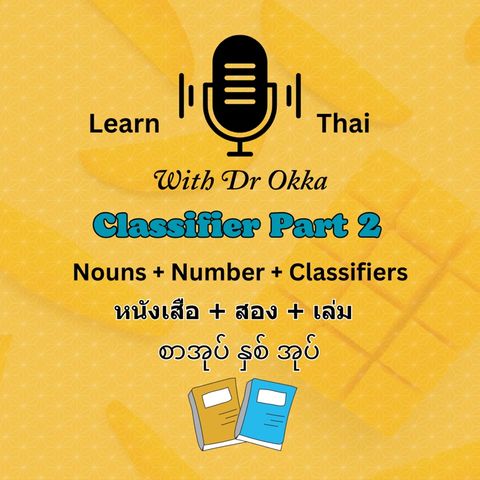Classifier Part 2

Descarga y escucha en cualquier lugar
Descarga tus episodios favoritos y disfrútalos, ¡dondequiera que estés! Regístrate o inicia sesión ahora para acceder a la escucha sin conexión.
Descripción
In the Thai language, **classifiers** (ลักษณนาม, "laksana naam") are used with numbers to count nouns, similar to "pieces" of paper or "slices" of bread in English. Classifiers follow a noun...
mostra más### 1. **Usage Structure**:
The typical structure when using classifiers is:
**[Noun] + [Number] + [Classifier]**
- Example:
- **หนังสือ 3 เล่ม** ("three books") → **หนังสือ** (book) + **3** + **เล่ม** (classifier for books).
### 2. **Common Classifiers**:
Classifiers are specific to the noun's type, and there are hundreds of them. Here are some common ones:
- **คน** (_khon_) → used for people.
- Example: นักเรียน 2 คน (two students)
- **ตัว** (_tua_) → used for animals, clothes, chairs, and some items.
- Example: สุนัข 1 ตัว (one dog)
- **เล่ม** (_lem_) → used for books, knives, and items with a blade.
- Example: หนังสือ 5 เล่ม (five books)
- **ใบ** (_bai_) → used for flat objects like papers, bags, leaves.
- Example: ใบไม้ 3 ใบ (three leaves)
- **อัน** (_an_) → used for small, round objects or items.
- Example: นาฬิกา 1 อัน (one clock)
- **ดอก** (_dok_) → used for flowers.
- Example: ดอกไม้ 4 ดอก (four flowers)
- **แผ่น** (_phaen_) → used for flat, thin objects like paper, CDs, or slices.
- Example: กระดาษ 2 แผ่น (two sheets of paper)
- **หลัง** (_lang_) → used for houses or buildings.
- Example: บ้าน 1 หลัง (one house)
### 3. **Types of Classifiers**:
Classifiers can be categorized based on what they represent:
- **For living things**:
- **คน** (khon): people
- **ตัว** (tua): animals
- **For objects**:
- **เล่ม** (lem): books, knives
- **คัน** (khan): vehicles
- **เครื่อง** (khrueang): machines, electronic devices
- **For flat or small items**:
- **ใบ** (bai): bags, leaves
- **แผ่น** (phaen): sheets of paper, slices
- **For sets or groups**:
- **ชุด** (chut): set of clothing or objects
- **กลุ่ม** (klum): groups of people
### 4. **Special Classifiers**:
Some nouns have unique classifiers not following the general patterns:
- **พระ** (_phra_) → used for monks.
- **องค์** (_ong_) → used for deities or important religious objects/statues.
- **คำ** (_kham_) → used for words or speech.
### 5. **Generic Classifier**:
- **อัน** (_an_) can be used generically when the exact classifier is not known, especially for inanimate objects.
### 6. **Special Rules**:
- Some nouns don’t use classifiers when measured in units of weight, volume, or area (e.g., 5 kilograms of rice = ข้าว 5 กิโลกรัม, not ข้าว 5 กิโลกรัมอัน).
- When describing a person with certain qualities (e.g., professions), **คน** is the default classifier. For example, นักร้อง 1 คน (one singer).
### 7. **Plural Nouns**:
Thai doesn’t explicitly mark plurals. Instead, it relies on numbers or context, and classifiers play a key role in indicating quantity.
### 8. **Questions about Quantity**:
To ask how many of something there are, use:
- **[Noun] + กี่ + [Classifier]?** (How many [classifier] of [noun]?)
- Example: หนังสือกี่เล่ม? (How many books?)
### 9. **Exceptions and Irregularities**:
- Some items may use multiple classifiers depending on the context. For instance, **แก้วน้ำ** (glass of water) can use **ใบ** (bai, for the container) or **แก้ว** (kaew, specific to glasses).
### 10. **Cultural Relevance**:
Classifiers are deeply embedded in Thai culture, and native speakers may sometimes omit them in informal speech, but they are crucial for proper and polite communication.
Understanding Thai classifiers takes practice, but once familiar with the basic patterns, it becomes much easier to navigate.
Información
| Autor | Dr Okka Minn |
| Organización | Dr Okka Minn |
| Página web | - |
| Etiquetas |
-
|
Copyright 2024 - Spreaker Inc. an iHeartMedia Company
